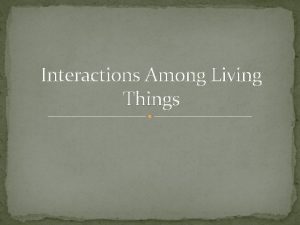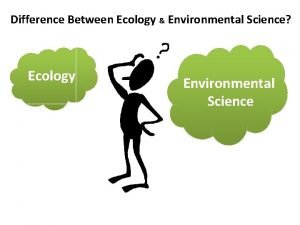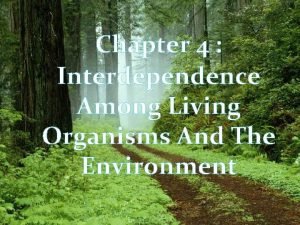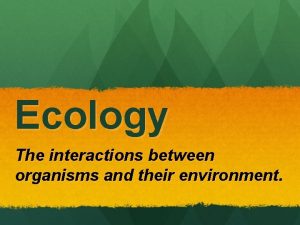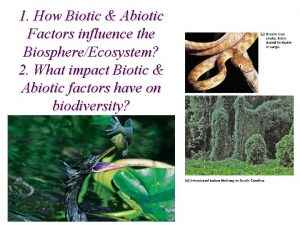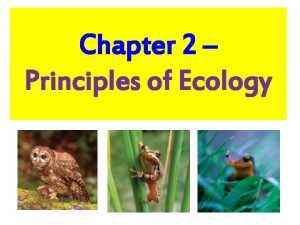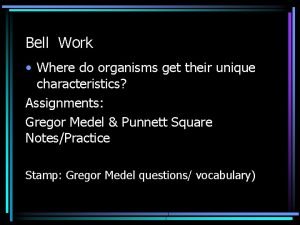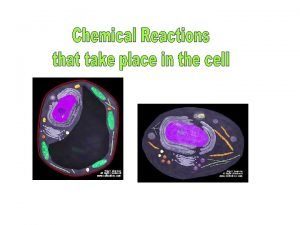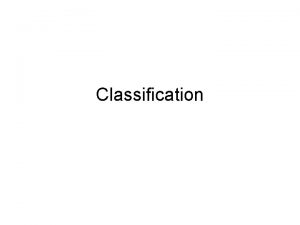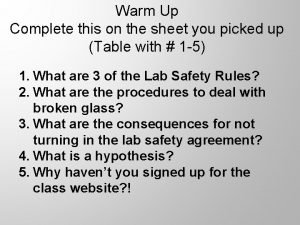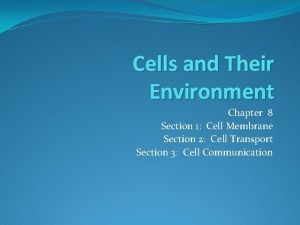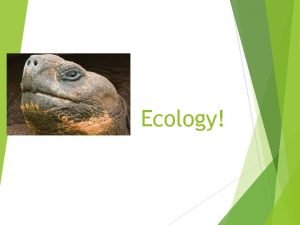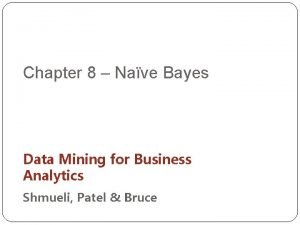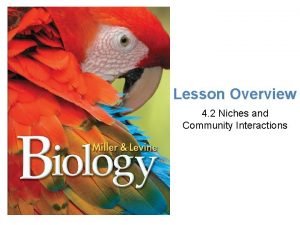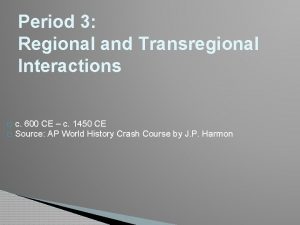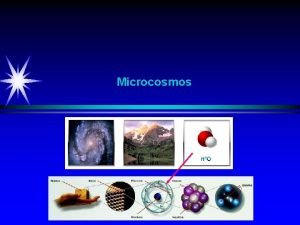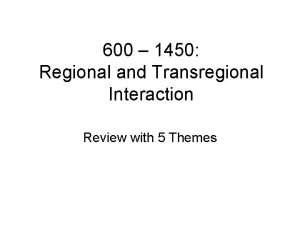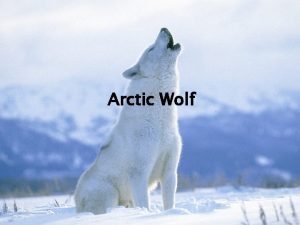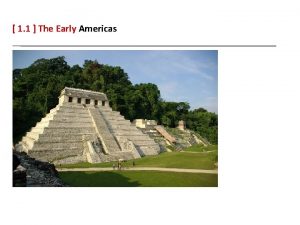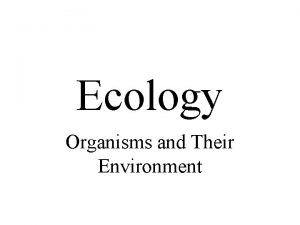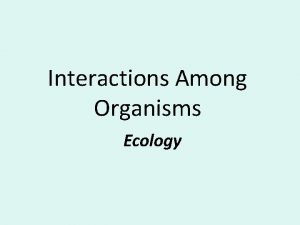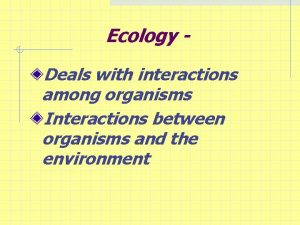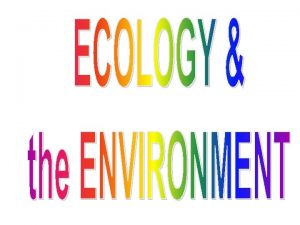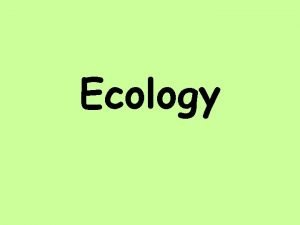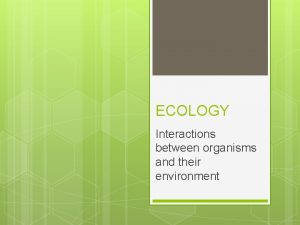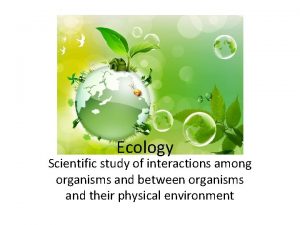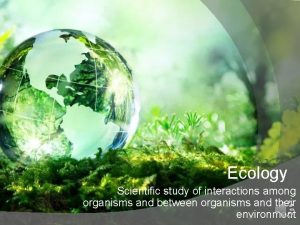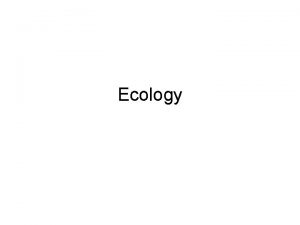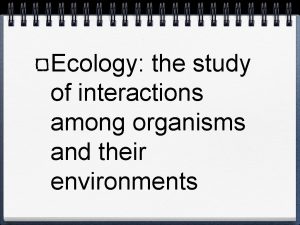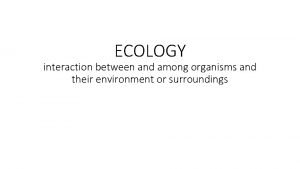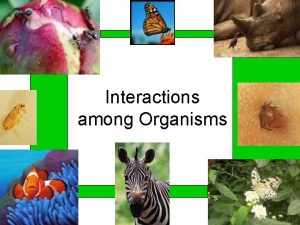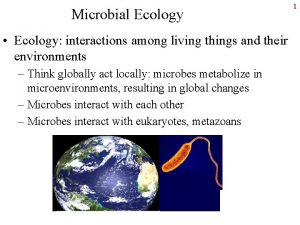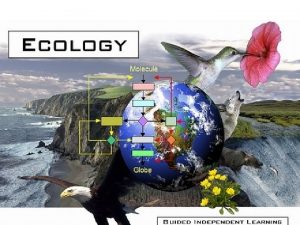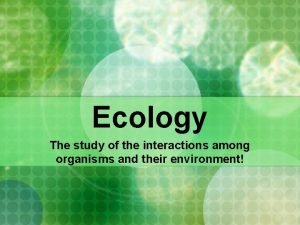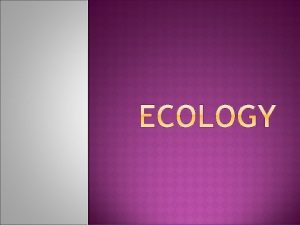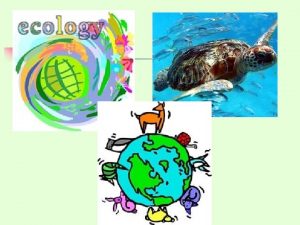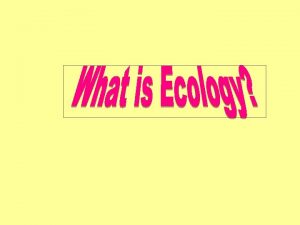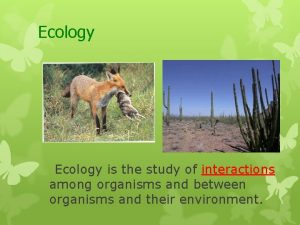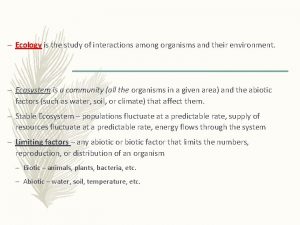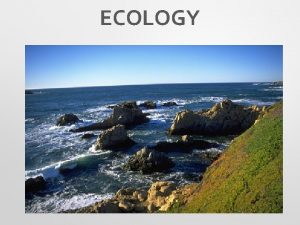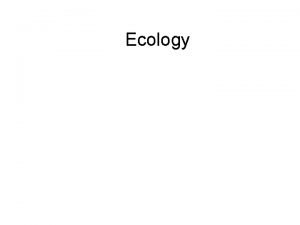ECOLOGY The interactions among organisms and their environment




















































- Slides: 52

ECOLOGY The interactions among organisms and their environment. Julia is really cool.

I. Abiotic Factors § Physical or nonliving factors that affect an ecosystem. Ex: Temperature, Light. Water, Soil

I. Abiotic Factors A. Temperature: 1. As latitude increases, temperature decreases. 2. As altitude increases, temperature decreases. 3. The closer to water, the cooler the temperature.

I. Abiotic Factors B. Light: 1. The lower the latitude, the higher the light intensity. 2. Plants closer to the surface of water receive more sunlight.

I. Abiotic Factors C. Water: 1. Conservation methods: § Water vacuoles for storage; § spending energy during the cool mornings or evenings (hunting/foraging) § Guard cells in plants 2. Water is important for all metabolic activities.

I. Abiotic Factors D. Soil: 1. Important parts: § Topsoil – At top; contains important minerals § Detritus – dead plant/animal material § Bedrock – good or poor drainage

Soil Profile

I. Abiotic Factors D. Soil: 2. Plants need certain minerals to grow such as N, K, P, Mg, and Ca.

II. Biotic Factors § All living things that have an affect on an ecosystem. Ex: Birds, bacteria, plants, insects, humans, etc…

A. Organization within the Biosphere 1. Biosphere – Part of the Earth where life exists. 2. Population – A group of individuals of the same species living in the same area. 3. Community – A group of different populations living in the same area. 4. Ecosystem – All biotic and abiotic factors in a certain area.

What 3 things must an ecosystem have to be self-sustaining? a. Constant supply of energy b. Biodiversity c. Recycling of materials between organisms and the environment.

III. Interactions in the Ecosystem A. Niche – An organisms role in its ecosystem. (Ex: A lioness is a hunter) B. Niche Competition: Two or more organisms competing for the same role in an ecosystem. (Ex: Wolverine vs. wolf) C. Energy Flow Relationships: There is the greatest amount of stored energy at the Producer level.

C. Energy Flow Relationships Mode of Nutrition Food Chain Component Example Autotrophs Producer Plants Herbivores Primary consumer Crickets; beetles; lady bugs Herbivores Primary consumer (plants) Rabbits; deer; squirrels Carnivores Secondary consumer (meat) Snakes; wolves; hawks Omnivores Secondary consumer (any food) Humans; bears; Lions Saprophytes Decomposer Bacteria

1. Food Chain

2. Food Web


3. Food Pyramid § The further along the food chain you go, the less food (and hence energy) remains available.

4. Ecological Relationships 1. Predator/Prey – One organism hunts, kills, and eats another weaker organism. Ex: Lion hunts a gazelle

4. Ecological Relationships 2. Symbiosis: 2 organisms living/working in close contact. a. Commensalism (+, 0): One organism benefits; the other is not affected. Ex: Sharks and Remora fish


4. Ecological Relationships b. Mutualism (+, +): Both organisms benefit from the relationship. Ex: Termites have cellulose digesting bacteria in their gut. Clownfish and sea anemones

Other fish might think it’s safe!!

4. Ecological Relationships c. Parasitism (+, -): One organism benefits; the other is negatively affected. Ex: Tapeworms and dogs Lamprey and Trout


Changes in an Ecosystem Ecological Succession: The process by which an existing community is gradually replaced by another community

Ecological Succession 1. Pioneer Species: The first organism to inhabit an area. (Ex: Lichens) 2. Climax Community: A mature, stable community.

Ecological Succession Examples: § Volcanic Islands § Rocky Cliffs § Plowed Fields

Ecological Succession

Ecological Succession

Nutrient Cycles § Nitrogen Cycle – Dead organic material and nitrogenous wastes are broken down into usable parts for autotrophs

Carbon/Oxygen Cycle – Plants use CO 2 for photosynthesis; Humans use O 2 for cellular respiration.

Water (Hydrologic) Cycle

BIOME A very large area characterized by a certain climate and types of plants and animals.

V. Biomes (pg. 98 – 107) Tundra

Biomes Tropical Rain Forests

Biomes Taiga

Biomes Temperate Deciduous Forest

Biomes Grassland

Biomes Desert

Biomes Oceans

Marine Ecosystems § § § Most stable ecosystem on Earth Absorbs and holds solar heat Constant supplies of nutrients Largest habitat for many life forms Most photosynthesis occurs in this biome

VI. Human Ecology A. Human Population Growth 1. Limiting Factor: Lack of food, water supply, space, or any other necessity. 2. Carrying Capacity: The size of a population that can be supported by the environment.

VI. Human Ecology B. Negative Human Activities 1. Overhunting: Killing too many of a certain species. 2. Exploitation of Wildlife: Capturing animals for display. 3. Poor Land Management: Lack of ground cover; overgrazing; overall failure to take care of land.

VI. Human Ecology B. Negative Human Activities 4. Importation of Organisms: Bringing foreign species into an area. 5. Water Pollution: a. Eutrophication – Decrease the amount of oxygen due to chemical pollution and overgrowth of algae. b. Dumping of Chemicals – Pesticides, fertilizers, detergents dumped into water.

VI. Human Ecology B. Negative Human Activities 5. Water Pollution: c. E. coli Contamination – Human and animal wastes are dumped into water. d. Thermal Pollution – The heat from factories close to water can kill marine life.

VI. Human Ecology B. Negative Human Activities 6. Air Pollution: A. Sulfur Dioxide – Acid rain is produced from exhaust. B. Smog – Smoke, gas, and fog warmed by sunlight. C. Temperature Inversion – Cool air is trapped under warm air, which traps pollutants.

VI. Human Ecology B. Negative Human Activities 7. Land Pollution: a. Landfills/Incineration – Refuse is dumped and burned. b. Pesticides – Contaminates air, water, and land.

VI. Human Ecology C. Positive Human Activities 1. Conservation of Resources a. Increased use of renewable resources. (air, water, sunlight, soil, living organisms) b. Recycling c. Decreased use of non-renewable resources (coal, oil, natural gas, metals, minerals)

VI. Human Ecology C. Positive Human Activities 2. Types of Conservation: a. Soil conservation – prevents erosion b. Forest conservation – Reforestation c. Wildlife conservation – Hunting/fishing laws; Nature preserves; Endangered Species Act

VI. Human Ecology C. Positive Human Activities 3. Pollution Control: a. Natural enemies – natural predators to control pests. b. Bacterial controls – Use bacteria and viruses against pests.

VI. Human Ecology C. Positive Human Activities 3. Pollution Control: c. Crop rotation – Different crops each year. d. Pheromones – Chemical communication between members of the same species. Insect traps! e. Sterile males = No offspring to control populations.

 Biotic
Biotic Principles of ecology chapter 2 section 2 answer key
Principles of ecology chapter 2 section 2 answer key Section 1 organisms and their relationships
Section 1 organisms and their relationships Congress formal and informal powers
Congress formal and informal powers Interactions among living things
Interactions among living things Interactions in the environment grade 7
Interactions in the environment grade 7 Unicellular and multicellular.
Unicellular and multicellular. Levels of organization in the biosphere
Levels of organization in the biosphere Ecology and environment difference
Ecology and environment difference Environment vs ecology
Environment vs ecology Interdependence among living organisms
Interdependence among living organisms Why do organisms interact with other organisms
Why do organisms interact with other organisms Organisms and the environment
Organisms and the environment Whats a niche in biology
Whats a niche in biology Principles of ecology chapter 2 section 1 answer key
Principles of ecology chapter 2 section 1 answer key Principles of ecology section 2 flow of energy
Principles of ecology section 2 flow of energy Chapter 2 section 1 organisms and their relationships
Chapter 2 section 1 organisms and their relationships 5 levels of organisms
5 levels of organisms Chapter 2 section 1 organisms and their relationships
Chapter 2 section 1 organisms and their relationships Where do organisms get their traits?
Where do organisms get their traits? Where do all organisms get their energy
Where do all organisms get their energy The process of grouping things based on their similarities.
The process of grouping things based on their similarities. Organisms that make their own food
Organisms that make their own food Accounting information system chapter 1
Accounting information system chapter 1 Cells and their environment worksheet answers
Cells and their environment worksheet answers Environment of business finance
Environment of business finance Qualitative vs quantitative
Qualitative vs quantitative Unit 5 macroeconomics lesson 2 activity 45
Unit 5 macroeconomics lesson 2 activity 45 The properties and interactions of magnets
The properties and interactions of magnets How do earth's spheres interact
How do earth's spheres interact 6.1 habitats, niches, and species interactions answer key
6.1 habitats, niches, and species interactions answer key Integral vs modular architecture
Integral vs modular architecture One factor that influences positive communication
One factor that influences positive communication Symbiosis and species interactions keystone webquest
Symbiosis and species interactions keystone webquest Naive bayes pays attention to complex interactions and
Naive bayes pays attention to complex interactions and Product architecture diagram
Product architecture diagram Niches and community interactions
Niches and community interactions Regional and transregional interactions
Regional and transregional interactions Neutrinous
Neutrinous Regional and transregional interactions
Regional and transregional interactions Arctic wolf physical description
Arctic wolf physical description Anasazi religion and gods
Anasazi religion and gods What represents an aztec adaptation to their environment
What represents an aztec adaptation to their environment Translation of romeo and juliet prologue
Translation of romeo and juliet prologue Hình ảnh bộ gõ cơ thể búng tay
Hình ảnh bộ gõ cơ thể búng tay Frameset trong html5
Frameset trong html5 Bổ thể
Bổ thể Tỉ lệ cơ thể trẻ em
Tỉ lệ cơ thể trẻ em Gấu đi như thế nào
Gấu đi như thế nào Tư thế worms-breton
Tư thế worms-breton Chúa yêu trần thế alleluia
Chúa yêu trần thế alleluia Các môn thể thao bắt đầu bằng tiếng nhảy
Các môn thể thao bắt đầu bằng tiếng nhảy Thế nào là hệ số cao nhất
Thế nào là hệ số cao nhất




